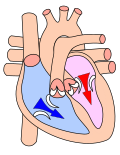Diastole
Diastole is the part of the cardiac cycle when the heart relaxes and fills with blood. This occurs between contractions (systole), specifically between the second and first heart sounds. It is the longest phase of the cardiac cycle and includes both early diastole, when the ventricles first relax and start to fill; and late diastole, when the ventricles complete filling with blood from the atria.
Phases of Diastole
Diastole is divided into four phases: isovolumetric relaxation, rapid filling, diastasis, and atrial contraction.
Isovolumetric Relaxation
This is the initial phase of diastole. During this phase, the ventricles begin to relax and the pressure within the ventricles drops. The aortic valve and pulmonary valve close to prevent the backflow of blood into the ventricles. The mitral valve and tricuspid valve are also closed at this time, so no blood is entering the ventricles, hence the term "isovolumetric".
Rapid Filling
In the rapid filling phase, the pressure in the atria becomes higher than the pressure in the ventricles. This causes the mitral and tricuspid valves to open, allowing blood to flow into the ventricles. This phase is called "rapid filling" because it is the phase where the ventricles fill the fastest.
Diastasis
Diastasis is a slower filling phase that occurs before the atria contract. During this phase, blood continues to flow into the ventricles, but at a slower rate.
Atrial Contraction
The final phase of diastole is atrial contraction. During this phase, the atria contract, pushing the remaining blood into the ventricles. This phase is also known as "atrial kick" because it provides the final push of blood to fill the ventricles before the next contraction.
Clinical Significance
Abnormalities in diastole can lead to diastolic heart failure, where the heart is unable to fill properly. This can result in symptoms such as shortness of breath, fatigue, and edema. Diastolic dysfunction can be caused by conditions such as hypertension, coronary artery disease, and aging.
See Also
References
Transform your life with W8MD's budget GLP-1 injections from $125.
W8MD offers a medical weight loss program to lose weight in Philadelphia. Our physician-supervised medical weight loss provides:
- Most insurances accepted or discounted self-pay rates. We will obtain insurance prior authorizations if needed.
- Generic GLP1 weight loss injections from $125 for the starting dose.
- Also offer prescription weight loss medications including Phentermine, Qsymia, Diethylpropion, Contrave etc.
NYC weight loss doctor appointments
Start your NYC weight loss journey today at our NYC medical weight loss and Philadelphia medical weight loss clinics.
- Call 718-946-5500 to lose weight in NYC or for medical weight loss in Philadelphia 215-676-2334.
- Tags:NYC medical weight loss, Philadelphia lose weight Zepbound NYC, Budget GLP1 weight loss injections, Wegovy Philadelphia, Wegovy NYC, Philadelphia medical weight loss, Brookly weight loss and Wegovy NYC
|
WikiMD's Wellness Encyclopedia |
| Let Food Be Thy Medicine Medicine Thy Food - Hippocrates |
Medical Disclaimer: WikiMD is not a substitute for professional medical advice. The information on WikiMD is provided as an information resource only, may be incorrect, outdated or misleading, and is not to be used or relied on for any diagnostic or treatment purposes. Please consult your health care provider before making any healthcare decisions or for guidance about a specific medical condition. WikiMD expressly disclaims responsibility, and shall have no liability, for any damages, loss, injury, or liability whatsoever suffered as a result of your reliance on the information contained in this site. By visiting this site you agree to the foregoing terms and conditions, which may from time to time be changed or supplemented by WikiMD. If you do not agree to the foregoing terms and conditions, you should not enter or use this site. See full disclaimer.
Credits:Most images are courtesy of Wikimedia commons, and templates, categories Wikipedia, licensed under CC BY SA or similar.
Contributors: Prab R. Tumpati, MD



